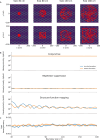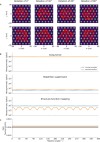Quantitative modeling of the emergence of macroscopic grid-like representations
- PMID: 39212203
- PMCID: PMC11364436
- DOI: 10.7554/eLife.85742
Quantitative modeling of the emergence of macroscopic grid-like representations
Abstract
When subjects navigate through spatial environments, grid cells exhibit firing fields that are arranged in a triangular grid pattern. Direct recordings of grid cells from the human brain are rare. Hence, functional magnetic resonance imaging (fMRI) studies proposed an indirect measure of entorhinal grid-cell activity, quantified as hexadirectional modulation of fMRI activity as a function of the subject's movement direction. However, it remains unclear how the activity of a population of grid cells may exhibit hexadirectional modulation. Here, we use numerical simulations and analytical calculations to suggest that this hexadirectional modulation is best explained by head-direction tuning aligned to the grid axes, whereas it is not clearly supported by a bias of grid cells toward a particular phase offset. Firing-rate adaptation can result in hexadirectional modulation, but the available cellular data is insufficient to clearly support or refute this option. The magnitude of hexadirectional modulation furthermore depends considerably on the subject's navigation pattern, indicating that future fMRI studies could be designed to test which hypothesis most likely accounts for the fMRI measure of grid cells. Our findings also underline the importance of quantifying the properties of human grid cells to further elucidate how hexadirectional modulations of fMRI activity may emerge.
Keywords: entorhinal cortex; functional magnetic resonance imaging; grid cells; human; navigation; neuroscience; rodents.
© 2024, Bin Khalid, Reifenstein et al.
Conflict of interest statement
IB, ER, NA, LK, RK No competing interests declared
Figures

















Update of
- doi: 10.1101/2022.12.20.521210
References
-
- Banino A, Barry C, Uria B, Blundell C, Lillicrap T, Mirowski P, Pritzel A, Chadwick MJ, Degris T, Modayil J, Wayne G, Soyer H, Viola F, Zhang B, Goroshin R, Rabinowitz N, Pascanu R, Beattie C, Petersen S, Sadik A, Gaffney S, King H, Kavukcuoglu K, Hassabis D, Hadsell R, Kumaran D. Vector-based navigation using grid-like representations in artificial agents. Nature. 2018;557:429–433. doi: 10.1038/s41586-018-0102-6. - DOI - PubMed
-
- Behuet S, Bludau S, Kedo O, Schiffer C, Dickscheid T, Brandstetter A, Massicotte P, Omidyeganeh M, Evans A, Amunts K. A High-Resolution Model of the Human Entorhinal Cortex in the ‘BigBrain’ – Use Case for Machine Learning and 3D Analyse. Brain-inspired computing: 4th international workshop, BrainComp 2019, Cetraro, taly, July 15–19, 2019, Revised Selected Papers 4; 2021. pp. 3–21. - DOI
-
- Bierbrauer A, Kunz L, Gomes CA, Luhmann M, Deuker L, Getzmann S, Wascher E, Gajewski PD, Hengstler JG, Fernandez-Alvarez M, Atienza M, Cammisuli DM, Bonatti F, Pruneti C, Percesepe A, Bellaali Y, Hanseeuw B, Strange BA, Cantero JL, Axmacher N. Unmasking selective path integration deficits in Alzheimer’s disease risk carriers. Science Advances. 2020;6:eaba1394. doi: 10.1126/sciadv.aba1394. - DOI - PMC - PubMed
MeSH terms
Grants and funding
LinkOut - more resources
Full Text Sources
Medical

